2702 scholarly books by University of Chicago Press Journals and 14
have author last names that start with M
2702 scholarly books by University of Chicago Press Journals and 14
2702 scholarly books by University of Chicago Press Journals
14 have author last names that start with M have author last names that start with M
14 have author last names that start with M have author last names that start with M
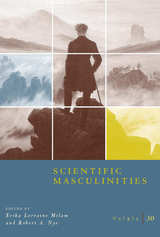
Osiris, Volume 30
Scientific Masculinities
Erika Lorraine Milam
University of Chicago Press Journals, 2015
This volume of Osiris integrates gender analysis with the global history of science and medicine from the late Middle Ages to the present by focusing on masculinity. The premise is that social constructions of masculinity function simultaneously as foils for femininity and as methods of differentiating between “kinds” of men. In exploring scientific masculinities, the book asks: how has masculinity been defined, and what are the mechanisms by which it operates in science? The essays are divided into sections that emphasize the importance of gender to the practices of professionalization, the spaces in which scientific, technological, and medical labor is performed, and the ways that sex, gender, and sexual orientation are measured and serve as metaphors in society and culture.
[more]
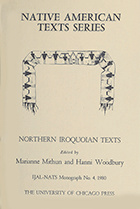
Northern Iroquoian Texts
Marianne Mithun
University of Chicago Press Journals, 1980
This volume includes 18 texts in a variety of genres from Northern Iorquoian languages with word-by-word glosses, making explicit the richness of Iroquoian grammar as it is used in context. This collection will be of interest to anthropologists, linguists, typologists, and aficionados of oral narrative, as well as to speakers and learners of Iroquoian languages.
[more]
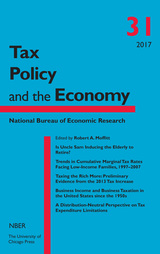
Tax Policy and the Economy, Volume 31
Robert A. Moffitt
University of Chicago Press Journals, 2017
The papers in Tax Policy and the Economy Volume 31 are all directly related to important and often long-standing issues, often including how transfer programs affect tax rates and behavior. In the first paper, Alan Auerbach, Laurence Kotlikoff, Darryl Koehler, and Manni Yu take a lifetime perspective on the marginal tax rates facing older individuals and families arising from a comprehensive set of sources. In the second, Gizem Kosar and Robert A. Moffitt provide new estimates of the cumulative marginal tax rates facing low-income families over the period 1997-2007. In the third paper, Emmanuel Saez presents evidence on the elasticity of taxable income with respect to tax rates, drawing on data from the 2013 federal income tax reform. In the fourth, Conor Clarke and Wojciech Kopczuk survey the treatment of business income taxation in the United States since the 1950s, providing new data on how business income and its taxation have evolved over time. In the fifth paper, Louis Kaplow argues that the reduction in statutory tax rates from base-broadening may not reduce effective marginal tax rates on households.
[more]
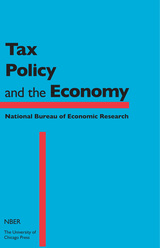
Tax Policy and the Economy
Volume 32
Robert A. Moffitt
University of Chicago Press Journals, 2018
The six research studies in Volume 32 of Tax Policy and the Economy analyze the U.S. tax and transfer system, in particular its effects on revenues, expenditures, and economic behavior. First, James Andreoni examines donor advised funds, which are financial vehicles offered by investment houses to provide savings accounts for tax-free charitable giving, and weighs their effects on donations against their tax cost. Second, Caroline Hoxby analyzes the use of tax credits by students enrolled in online post-secondary education. Third, Alex Rees-Jones and Dmitry Taubinsky explore taxpayers’ psychological biases that lead to incorrect perceptions and understanding of tax incentives. Fourth, Jeffrey Clemens and Benedic Ippolito investigate the implications of block grant reforms of Medicaid for receipt of federal support by different states. Fifth, Andrew Samwick examines means-testing of Medicare and federal health benefits under the Affordable Care Act. Sixth, Bruce Meyer and Wallace Mok study the incidence and effects of disability among U.S. women from 1968 to 2015, examining the impacts of disability on income, consumption, and public transfers.
[more]
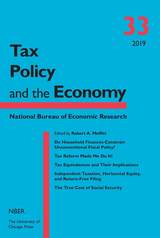
Tax Policy and the Economy, Volume 33
Robert A. Moffitt
University of Chicago Press Journals, 2019
This volume presents five new studies on taxation and government transfer programs. Alexander Blocker, Laurence Kotlikoff, Stephen Ross, and Sergio Villar Vallenas show how asset pricing can be used to value implicit fiscal debts, which are currently rarely measured or adjusted for risk, while accounting for risk properties. They apply their methodology to study Social Security. Michelle Hanson, Jeffrey Hoopes, and Joel Slemrod examine the effects of the Tax Cuts and Jobs Act on corporation behavior and on firms’ statements about their behavior. They focus on for four outcomes: bonuses, investment, share repurchases, and dividends. Scott Baker, Lorenz Kueng, Leslie McGranahan, and Brian Melzer explore whether “unconventional” fiscal policy in the form of pre-announced consumption tax changes can shift durables purchases intertemporally, how it such shifts are affected by consumer credit. Alan Auerbach discusses “tax equivalences,” disparate sets of policies that have the same economic effects, and also illustrates when these equivalences break down. Jeffrey Liebman and Daniel Ramsey use data from NBER’s TAXSIM model to investigate the equity implications of a switch from joint to independent taxation that could occur in conjunction with adoption of return-free tax filing.
[more]
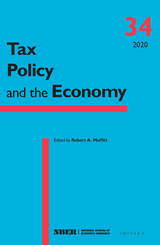
Tax Policy and the Economy, Volume 34
Robert A. Moffitt
University of Chicago Press Journals, 2020
This volume presents five new studies on current topics in taxation and government spending. Mark Shepard, Katherine Baicker, and Jonathan Skinner explore implementation aspects of a Medicare-for-All program, which provides a uniform health insurance benefit to everyone, and contrast it with a program providing a basic benefit that can be supplemented voluntarily. John Beshears, James Choi, Mark Iwry, David John, David Laibson, and Brigitte Madrian examine the design and feasibility of firm-sponsored “rainy day funds,” short-term savings accounts for employees that can be used when faced with temporary periods of high expenditure. Robert Barro and Brian Wheaton investigate the impact of taxation on choice of corporate form, on the formation and legal structure of new businesses, and indirectly on productivity in the economy. Jonathan Meer and Benjamin Priday examine the impact of the 2017 federal income tax reform, which reduced marginal tax rates and the incentive for charitable giving, on such giving. Finally, Casey Mulligan analyzes the impact of the Affordable Care Act on whether firms employ fewer than 50 employees, the employment threshold below which they are exempt from the requirement to provide health insurance to their employees.
[more]
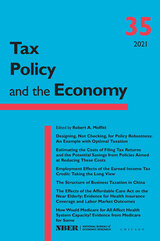
Tax Policy and the Economy, Volume 35
Robert A. Moffitt
University of Chicago Press Journals, 2021
This volume presents six new studies on current topics in taxation and government spending. The first study looks at the costs of income tax filing, which have risen over time because of the numerous tax forms families have to fill out when filing their taxes and because of increased costs of itemizing deductions, and explores ways to simplify filing and reduce those costs. The second study investigates the design of income tax schedules when there is uncertainty about the way taxation affects household behavior. The third study provides new and comprehensive estimates of the impact of the US Earned Income Tax Credit on the employment of low-income men and women, finding that the large majority of the various expansions of that credit over the last forty years have increased employment of single mothers. The fourth study reviews the structure of business taxation in China and describes a number of tax distortions and potential inefficiencies in the system. The next paper considers how the Affordable Care Act has affected the health insurance and labor market choices of individuals who are between the ages of 60 and 64, and it finds increases in insurance coverage and reductions in employment for some groups. The last study considers how reimbursement rates for health care providers under various government insurance programs affect providers’ willingness to take on new patients and expand their patient capacity.
[more]
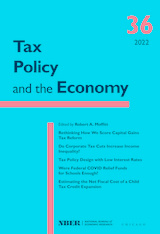
Tax Policy and the Economy, Volume 36
Robert A. Moffitt
University of Chicago Press Journals, 2022
This volume presents five new studies on current topics in taxation and government spending.
Natasha Sarin, Lawrence Summers, Owen Zidar, and Eric Zwick study how investors respond to taxes on capital gains, whether their incentives to invest are affected by those taxes, and whether that responsiveness has changed over time. Ethan Rouen, Suresh Nallareddy, and Juan Carlos Suárez Serrato revisit the question of whether cuts to corporate taxes increase income inequality, bringing new data and new statistical techniques to generate fresh findings. Alan Auerbach and William Gale investigate whether the advantages and disadvantages of different types of taxation are affected when interest rates stay low for long periods, as has been the case in the U.S. for many years. Nora Gordon and Sarah Reber study the distributional impact of emergency subsidies to schools made by the federal government during the recent COVID pandemic and whether those subsidies were sufficient to cover the increased school costs induced by the pandemic. Jacob Goldin, Elaine Maag, and Katherine Michelmore investigate the fiscal cost of an expansion of the U.S. child tax credit, which has been discussed extensively in policy circles recently. They take into account not only the direct expenditure on the allowance but how cost is affected by the existence of work incentives and by possible beneficial effects on childrens’ adult earnings.
Natasha Sarin, Lawrence Summers, Owen Zidar, and Eric Zwick study how investors respond to taxes on capital gains, whether their incentives to invest are affected by those taxes, and whether that responsiveness has changed over time. Ethan Rouen, Suresh Nallareddy, and Juan Carlos Suárez Serrato revisit the question of whether cuts to corporate taxes increase income inequality, bringing new data and new statistical techniques to generate fresh findings. Alan Auerbach and William Gale investigate whether the advantages and disadvantages of different types of taxation are affected when interest rates stay low for long periods, as has been the case in the U.S. for many years. Nora Gordon and Sarah Reber study the distributional impact of emergency subsidies to schools made by the federal government during the recent COVID pandemic and whether those subsidies were sufficient to cover the increased school costs induced by the pandemic. Jacob Goldin, Elaine Maag, and Katherine Michelmore investigate the fiscal cost of an expansion of the U.S. child tax credit, which has been discussed extensively in policy circles recently. They take into account not only the direct expenditure on the allowance but how cost is affected by the existence of work incentives and by possible beneficial effects on childrens’ adult earnings.
[more]
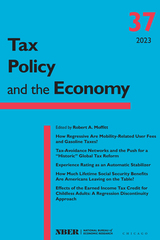
Tax Policy and the Economy, Volume 37
Robert A. Moffitt
University of Chicago Press Journals, 2023
Timely and authoritative research on the latest issues in tax policy.
Tax Policy and the Economy publishes current academic research on taxation and government spending with both immediate bearing on policy debates and longer-term interest.
This volume of Tax Policy and the Economy presents new research on important issues concerning US taxation and transfers. First, Edward L. Glaeser, Caitlin S. Gorback, and James M. Poterba examine the distribution of burdens associated with taxes on transportation. Replacing the gasoline tax with a vehicle-miles-traveled (VMT) tax would increase the burden on higher-income households, who drive more fuel-efficient cars and are more likely to own electric vehicles. User charges for airports, subways, and commuter rail are progressive, while the burden of bus fees is larger for lower-income households than for their higher-income counterparts. Next, Katarzyna Bilicka, Michael Devereux, and Irem Güçeri investigate tax shifting by multinational companies (MNCs) and the implications of a potential Global Minimum Tax (GMT). They find that MNCs shift intellectual property to tax havens, and that a large share of patenting activity takes place in tax havens where little or no R&D occurs. Tax havens are particularly important for MNCs with large subsidiary networks; such firms would likely be subject to a GMT. Mark Duggan, Audrey Guo, and Andrew C. Johnston study the role of experience rating in the Unemployment Insurance (UI) system and find that the current structure stabilizes the labor market because it penalizes firms with high rates of UI-eligible layoffs. In the fourth paper, David Altig, Laurence J. Kotlikoff, and Victor Yifan Ye calculate how retiring at different ages will affect Social Security benefit amounts, taking into account taxation and other benefits. They find that virtually all individuals aged 45 to 62 should wait until age 65 or later to maximize their Social Security benefits. Indeed, 90 percent would benefit from waiting until age 70, but only 10 percent do so. Finally, Jonathan Meer and Joshua Witter examine the potential impact of the Earned Income Tax Credit on the labor force decisions of childless adults who are eligible for a small credit after they reach age 25. Comparing labor force attachment changes just before and after this age suggests that the EITC has little impact on the labor force participation of this group.
Tax Policy and the Economy publishes current academic research on taxation and government spending with both immediate bearing on policy debates and longer-term interest.
This volume of Tax Policy and the Economy presents new research on important issues concerning US taxation and transfers. First, Edward L. Glaeser, Caitlin S. Gorback, and James M. Poterba examine the distribution of burdens associated with taxes on transportation. Replacing the gasoline tax with a vehicle-miles-traveled (VMT) tax would increase the burden on higher-income households, who drive more fuel-efficient cars and are more likely to own electric vehicles. User charges for airports, subways, and commuter rail are progressive, while the burden of bus fees is larger for lower-income households than for their higher-income counterparts. Next, Katarzyna Bilicka, Michael Devereux, and Irem Güçeri investigate tax shifting by multinational companies (MNCs) and the implications of a potential Global Minimum Tax (GMT). They find that MNCs shift intellectual property to tax havens, and that a large share of patenting activity takes place in tax havens where little or no R&D occurs. Tax havens are particularly important for MNCs with large subsidiary networks; such firms would likely be subject to a GMT. Mark Duggan, Audrey Guo, and Andrew C. Johnston study the role of experience rating in the Unemployment Insurance (UI) system and find that the current structure stabilizes the labor market because it penalizes firms with high rates of UI-eligible layoffs. In the fourth paper, David Altig, Laurence J. Kotlikoff, and Victor Yifan Ye calculate how retiring at different ages will affect Social Security benefit amounts, taking into account taxation and other benefits. They find that virtually all individuals aged 45 to 62 should wait until age 65 or later to maximize their Social Security benefits. Indeed, 90 percent would benefit from waiting until age 70, but only 10 percent do so. Finally, Jonathan Meer and Joshua Witter examine the potential impact of the Earned Income Tax Credit on the labor force decisions of childless adults who are eligible for a small credit after they reach age 25. Comparing labor force attachment changes just before and after this age suggests that the EITC has little impact on the labor force participation of this group.
[more]
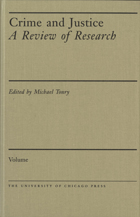
Crime and Justice, Volume 1
An Annual Review of Research
Norval Morris
University of Chicago Press Journals, 1980
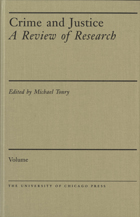
Crime and Justice, Volume 2
An Annual Review of Research
Norval Morris
University of Chicago Press Journals, 1981
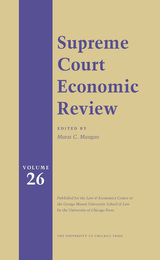
Murat C. Mungan
University of Chicago Press Journals
The Supreme Court Economic Review (SCER) is a faculty-edited, peer-reviewed, interdisciplinary law and economics series. The journal has a particular focus on economic and social science analysis of judicial decision-making, institutional analysis of law and legal structures, political economy and public choice issues regarding courts and other decision-makers, and the relationship between legal and political institutions and the institutions of a free society governed by constitutions and the rule of law. The series also publishes special symposium issues that build on SCER's traditional focus on the intersection between law and economics. The contributors include renowned legal scholars, economists, and policy-makers, and consistently ranks among the most influential journals of law and economics.
[more]
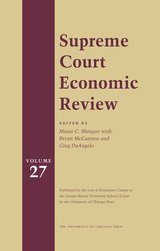
Murat C. Mungan
University of Chicago Press Journals
The Supreme Court Economic Review (SCER) is a faculty-edited, peer-reviewed, interdisciplinary law and economics series. The journal has a particular focus on economic and social science analysis of judicial decision-making, institutional analysis of law and legal structures, political economy and public choice issues regarding courts and other decision-makers, and the relationship between legal and political institutions and the institutions of a free society governed by constitutions and the rule of law. The series also publishes special symposium issues that build on SCER's traditional focus on the intersection between law and economics. The contributors include renowned legal scholars, economists, and policy-makers, and consistently ranks among the most influential journals of law and economics.
[more]
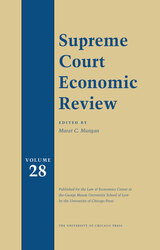
Murat C. Mungan
University of Chicago Press Journals
The Supreme Court Economic Review (SCER) is a faculty-edited, peer-reviewed, interdisciplinary law and economics series. The journal has a particular focus on economic and social science analysis of judicial decision-making, institutional analysis of law and legal structures, political economy and public choice issues regarding courts and other decision-makers, and the relationship between legal and political institutions and the institutions of a free society governed by constitutions and the rule of law. The series also publishes special symposium issues that build on SCER's traditional focus on the intersection between law and economics. The contributors include renowned legal scholars, economists, and policy-makers, and consistently ranks among the most influential journals of law and economics.
[more]
READERS
Browse our collection.
PUBLISHERS
See BiblioVault's publisher services.
STUDENT SERVICES
Files for college accessibility offices.
UChicago Accessibility Resources
home | accessibility | search | about | contact us
BiblioVault ® 2001 - 2024
The University of Chicago Press









